Jim Gill, president and chief executive officer at Gerald R. Ford International Airport (GRR), is the first to admit that he uses the word “collaboration” a lot when talking about the Grand Rapids, MI, airport—especially its $45 million Gateway Transformation Project. But with $17 million of the total cost coming from private donations, it is difficult to find a better descriptor.
Community involvement helped bring Phase 1 of the project to a close in September 2017, and the support continues as the airport prepares to kick off Phase 2 construction later this year. “This community is unlike any other,” Gill states categorically.
West Michigan has experienced tremendous growth over the years, and so has GRR. The Grand Rapids airport has logged record passenger numbers for five straight years. It finished 2017 with 2.81 million passengers, a 5.95% increase from 2016. And Gill says it is “definitely on pace for big numbers this year.” As of March 2018, year-to-date passenger traffic was up 15.3%.
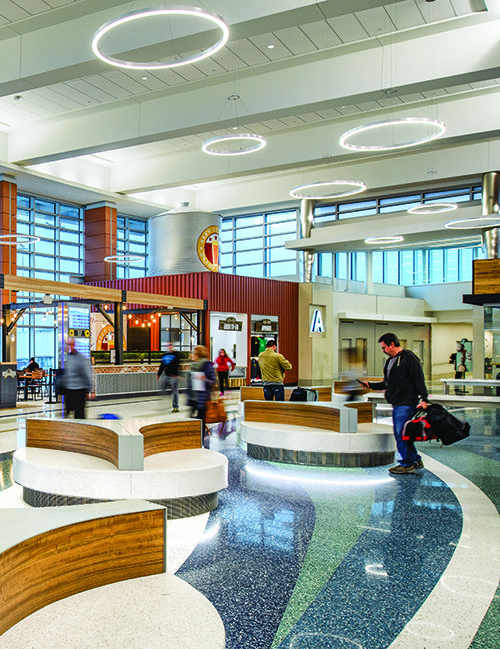
|
Project: Terminal Expansion/Enhancements Location: Gerald R. Ford Int’l Airport – Grand Rapids, MI Total Projected Cost: $45 million Design Architect: Alliiance Associate Architect/Engineer: TowerPinkster Concourse B General Contractor: The Christman Co. Food & Beverage Management: HMSHost Retail Management: Hudson Group Security/Technology Consultant: Faith Group Noteworthy Detail: Airport has received $17.1 million of private donations Title $8 Million Donor: Amway $1 Million+ Donors: Meijer; SpartanNash; Spectrum Health; Steelcase; Wolverine Worldwide $100,000+ Donors: Betz Industries; Bissell Foundation; CDV5 Foundation; Chemical Bank; The Christman Co.; Dick & Betsy DeVos Foundation; Fifth Third Bank; Frey Foundation; Herman Miller; Hudsonville Ice Cream; Irwin Seating; Old National Bank; Peter & Joan Secchia Foundation; PNC Bank; Richard & Helen DeVos; RoMan Manufacturing; Warner, Norcross & Judd |
The airport is not only a vital business driver for the community, it is also a reflection of the community. “We’re the front door,” Gill says. “The community wants us to do well and be representative of all the great things that are happening.”
At more than 50 years old, the facility was in need of modernization, he adds. “It was time to add some of those features that folks were starting to expect.”
To that end, the airport began construction of its Gateway Transformation Project Phase 1 in December 2015. Over a 21-month period, GRR added 59,000 square feet to the terminal to accommodate a new consolidated passenger screening checkpoint and improve the overall airport experience for travelers. Renovated restrooms, new concessions, four new business lounges, a post-checkpoint children’s playroom, mother’s nursing room and upgraded seating all combine to make the airport more comfortable for passengers.
“We try to give people in West Michigan not only the airport they want, but the airport they deserve,” Gill remarks. “We talk about our tagline all the time: ‘Getting there is better here,’ and we have to live to that mantra.”
Consolidated Passenger Screening
Prior to the renovation, GRR’s terminal was often described as institutional. “It could have been an airport or a hospital,” explains Tara Hernandez, GRR marketing and communications director. The redeveloped space, however, looks and feels much different. More natural light and an open design make the entire facility brighter and friendlier, she notes.
“As a design team, we’re always looking for inspiration and a baseline for what we’re trying to accomplish,” relates Eric Peterson, principal with Alliiance. “The airport’s attention to quality of space and its connection to the community helped us understand where we should go with the design.”
The design and finish materials in the new space celebrate West Michigan with subtle visual references to water, wind and the coast—from the terrazzo flooring to murals of regional scenes on the walls. Materials were also selected to blend with existing facilities. “They wanted it to have character, be expressive of the region and be a state-of-the-art facility—something that matches the aspirations and sophistication of the community itself,” Peterson explains.
“The idea was to represent the region the best way we can,” says Gill.
In addition to the openness and natural light, the redesigned space also provides future flexibility, notes Peterson. Recognizing that aviation, and particularly security, are dynamic environments, the design team worked to “remove as many encumbrances as possible so the facility has the greatest amount of flexibility.”
The focal point of Phase 1 was consolidating GRR’s two passenger screening checkpoints into one. Consolidation takes advantage of economies of scale and allows TSA to respond more effectively with staffing, Gill explains. “One location makes the process very efficient.”
Like the airport, TSA and its staff have to adjust to GRR’s tremendous growth. “TSA is a service partner with us,” states Gill. “They continue to support the opportunity to not only expand staff, but also equipment and facilities to make the process continue to be smooth.”
Previously, separate checkpoints in concourses A and B each had two screening lanes, plus the option to open a pre-check lane as demand warranted. The new consolidated checkpoint includes six screening lanes, a dedicated pre-check lane and the ability to add a seventh lane, pending equipment and staff.
The transition from two checkpoints to one was carefully coordinated to minimize disruption to passenger flow, says Brian Scherrer, project manager at Faith Group. While some of the TSA-provided equipment was installed before the move, the major shift was phased over the course of a weekend. “A lot of pre-planning in anticipation of the move helped it go very well,” reports Sal Mazzola, a senior security systems designer with the firm.
 Transforming Concessions
Transforming Concessions
A single, centralized screening checkpoint provides a more efficient security screening experience than the two separate checkpoints GRR previously had. It also allows passengers access to post-security amenities on both concourses.
Previously, food and beverage locations were concentrated before the TSA checkpoints. The additional square footage added during Phase 1 allowed for more post-security options. HMSHost focused on providing a blend of local and national offerings, just as travelers expect in today’s airports, says Bryan Loden, vice president of business development for the concessionaire. Prospect Hill Brewhouse, a new partnership with HMSHost, provides that local reflection. “They don’t want to look like ‘Any Airport, USA,” Loden explains. Experiencing a unique “hometown flavor” is something passengers appreciate at GRR, Gill adds.
Hudson Group opened several Michigan-themed retail locations behind the security checkpoint, including a Touch of Grand Rapids, which features regional foods, gifts, souvenirs, apparel and fashion accessories. The airport retailer also operates two Grand Rapids Magazine Travel Stores and two Destination Michigan locations that feature travel essentials and convenience products.
Gill notes that the new consolidated checkpoint makes it easier for travelers to spend their money. Rather than waiting in lengthy security lines, they are getting through in a more efficient manner with time to enjoy GRR’s concessions.
Loden reports that HMSHost sales are up about 45% year-to-date. He attributes the growth to the airport’s increasing traffic numbers and the variety and quality of food and beverage options now available to travelers. “We knew that the opportunity was there for an enhanced guest experience once the airport did this Transformation project; but we’re still very pleasantly surprised on how everything is going,” he says. As part of Phase 1, HMSHost gained nearly 4,000 square feet for its food and beverage program.
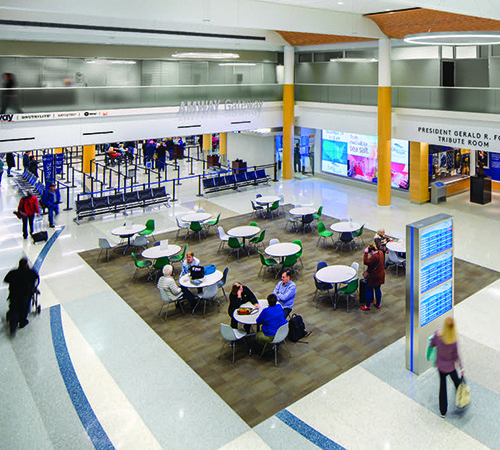 Technology Enhancements
Technology Enhancements
GRR also took the opportunity to make technology improvements. Specific projects include an access control upgrade, new video surveillance system, updating the flight information display system, dynamic signage improvements, a new 22-by-8-foot video wall at the front of the security checkpoint, a new communications room and installation of a queue management system for the passenger screening checkpoint.
The queue management system is a camera-based system that provides real-time analytics by measuring when passengers enter and exit the queue. The data it collects helps the airport and TSA managing staffing levels and informs travelers of the estimated processing times. “People can check that and plan ahead and have a more relaxed experience,” Scherrer notes.
The new communications room provides a secure, centralized data center for the airport and its tenants, with ample space for future enhancements. “The communications room that we built was very forward-looking to provide connectivity and growth,” says Mazzola.
Security cameras that can be adjusted remotely provide expanded and flexible surveillance coverage of the facility.
Transformative Funding
Like any airport, GRR was faced with how to finance its capital improvements. The West Michigan region has always been philosophically supportive of the airport, and that positive relationship helped spur the idea of soliciting local financial support for the renovation program, explains Gill. “We’re very fortunate that the community is so supportive of the airport,” he reflects.
The airport developed an outreach campaign in partnership with the Regional Air Alliance, an economic development group of West Michigan business leaders that focuses on supporting the airport. The mission of the campaign was to make sure that other business leaders understood exactly what they were investing in at GRR. “By far, it was an overwhelming success,” Gill reports.
Garnering financial contributions for the project was not a hard sell, he adds. “It really says something to me when you have business and community leaders that are willing to put their brand with and next to the airport brand. It shows the confidence they have in the airport.”
 In total, GRR received $17.1 million in private funds for the $45 million Gateway Transformation Project. Amway’s $8 million donation made it the title sponsor.
In total, GRR received $17.1 million in private funds for the $45 million Gateway Transformation Project. Amway’s $8 million donation made it the title sponsor.
Donations came in the form of cash, equipment and in-kind services. For instance, Steelcase donated money, furniture and helped build out the new business centers. “It’s a great way for them to show off their product,” Gill relates.
 SpartanNash, a grocery retailer and food distributor headquartered in West Michigan, sponsored the construction of the Military Welcome Center. Located pre-security, it provides refreshments, charging stations, flight information monitors and lounging space for active military members, veterans and their families. Spectrum Health Helen DeVos Children’s Hospital redesigned and added a new children’s play area, family restrooms and nursing rooms.
SpartanNash, a grocery retailer and food distributor headquartered in West Michigan, sponsored the construction of the Military Welcome Center. Located pre-security, it provides refreshments, charging stations, flight information monitors and lounging space for active military members, veterans and their families. Spectrum Health Helen DeVos Children’s Hospital redesigned and added a new children’s play area, family restrooms and nursing rooms.
In partnership with the Gerald R. Ford Presidential Foundation, the airport added an exhibit of photos, an aircraft carrier model and rotating pieces from the Gerald R. Ford Museum, dedicated to the airport’s namesake.
 Gill suspects that GRR’s transformation project would have moved forward without private contributions, but the burden of the associated debt service would have largely fallen on the backs of the airlines. “It wasn’t a matter of saying ‘forget about that consolidated checkpoint if you don’t come up with some money,’” he relates. Rather, it was an opportunity to engage the community and continue to make the airlines that serve the airport successful.
Gill suspects that GRR’s transformation project would have moved forward without private contributions, but the burden of the associated debt service would have largely fallen on the backs of the airlines. “It wasn’t a matter of saying ‘forget about that consolidated checkpoint if you don’t come up with some money,’” he relates. Rather, it was an opportunity to engage the community and continue to make the airlines that serve the airport successful.
“The community and the business leaders really ‘get it,’” explains Gill. “They understand the dynamics of the airport, they want to continue to see it grow, and they’re willing to do what they can to help.”
 “If we were running the airport into the ground and it was a dive, no one would want their name associated with it—and I wouldn’t blame them,” he continues. “So it creates for us another level of responsibility to make sure we carry that forward and always respect our namesake, but also the community that has literally and figuratively invested so much in the airport.”
“If we were running the airport into the ground and it was a dive, no one would want their name associated with it—and I wouldn’t blame them,” he continues. “So it creates for us another level of responsibility to make sure we carry that forward and always respect our namesake, but also the community that has literally and figuratively invested so much in the airport.”
Gill knows that the level of local support GRR receives is rare. “This sort of community collaboration with the airport is unheard of,” he acknowledges. “Sure, there’s partnerships that take place in other places, but we have the entire business community involved with our mission—without getting in the way and trying to tell us how to operate.”
Continuing the Transformation
 Phase 2 of the Gateway Transformation is currently in the planning stages and will update “front-of-house” areas such as ticketing and baggage claim. GRR is one of the few U.S. airports with CTX baggage screening machines still in the lobby. “The first order of business is to get those machines behind the wall,” Gill says.
Phase 2 of the Gateway Transformation is currently in the planning stages and will update “front-of-house” areas such as ticketing and baggage claim. GRR is one of the few U.S. airports with CTX baggage screening machines still in the lobby. “The first order of business is to get those machines behind the wall,” Gill says.
As with Phase 1, Phase 2 will focus on modernizing aesthetics and improving passenger convenience, while ensuring flexibility for the future. “If we grow, we want to make sure that we have the technology and assets in place to be able to respond to that from a passenger processing or airline standpoint,” explains Gill. Improvements to airline ticketing, baggage screening and baggage claim, as well as additional restrooms and more pre-security concessions are in the works to help meet those goals. Construction is expected to begin later this year and be complete by the end of 2019.
Additionally, officials are in the process of updating GRR’s master plan, which includes airside capacity enhancements to address growing traffic. “Our growth has been phenomenal, but we have to make sure that we’re always ready for that next level of growth,” Gill notes.
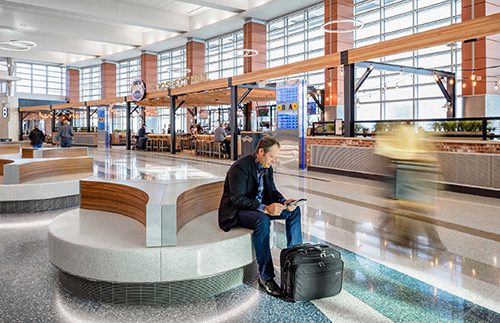
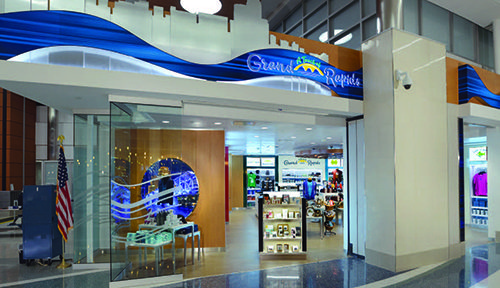
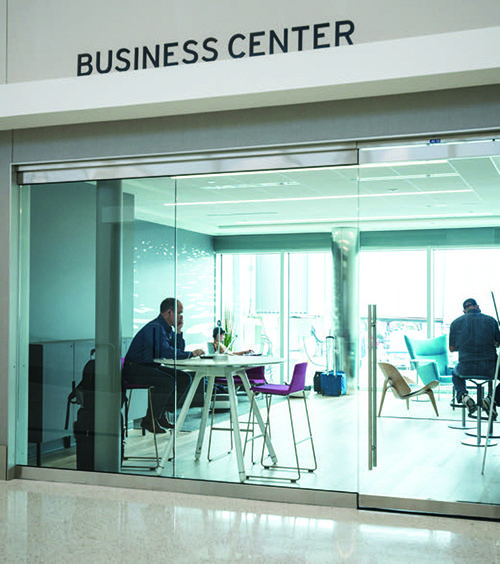

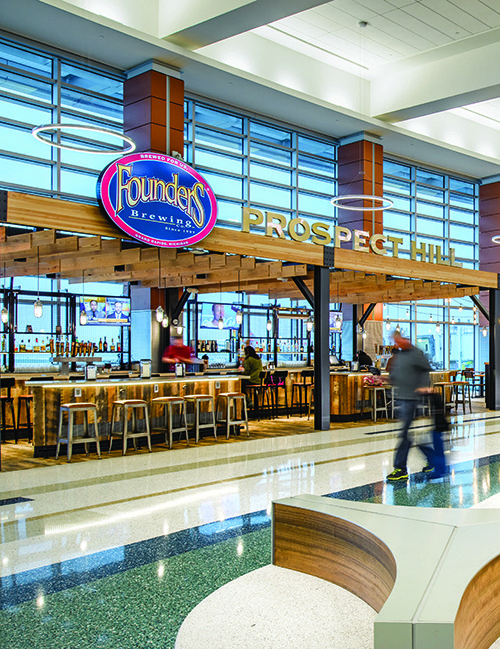
 facts&figures
facts&figures

